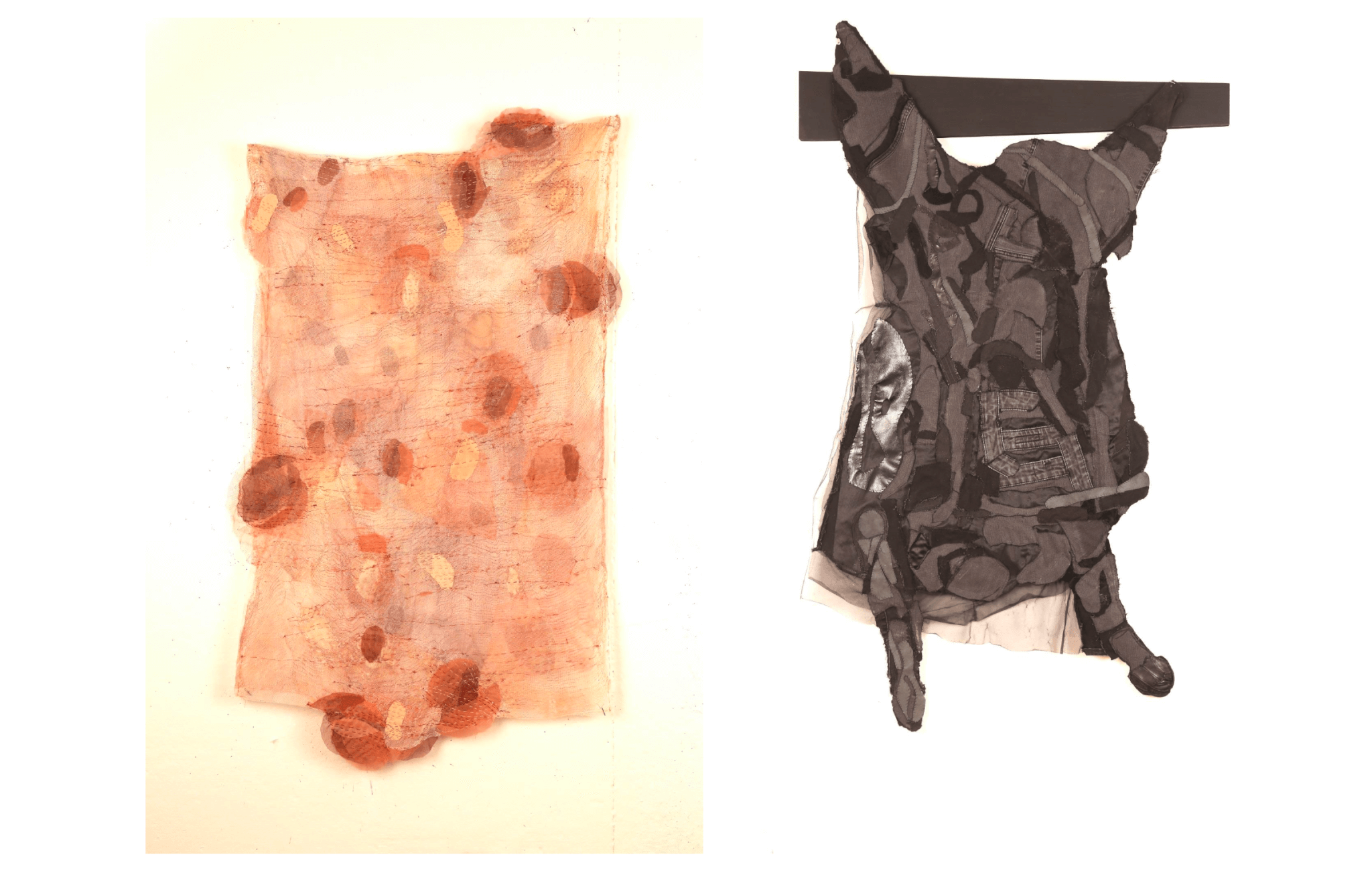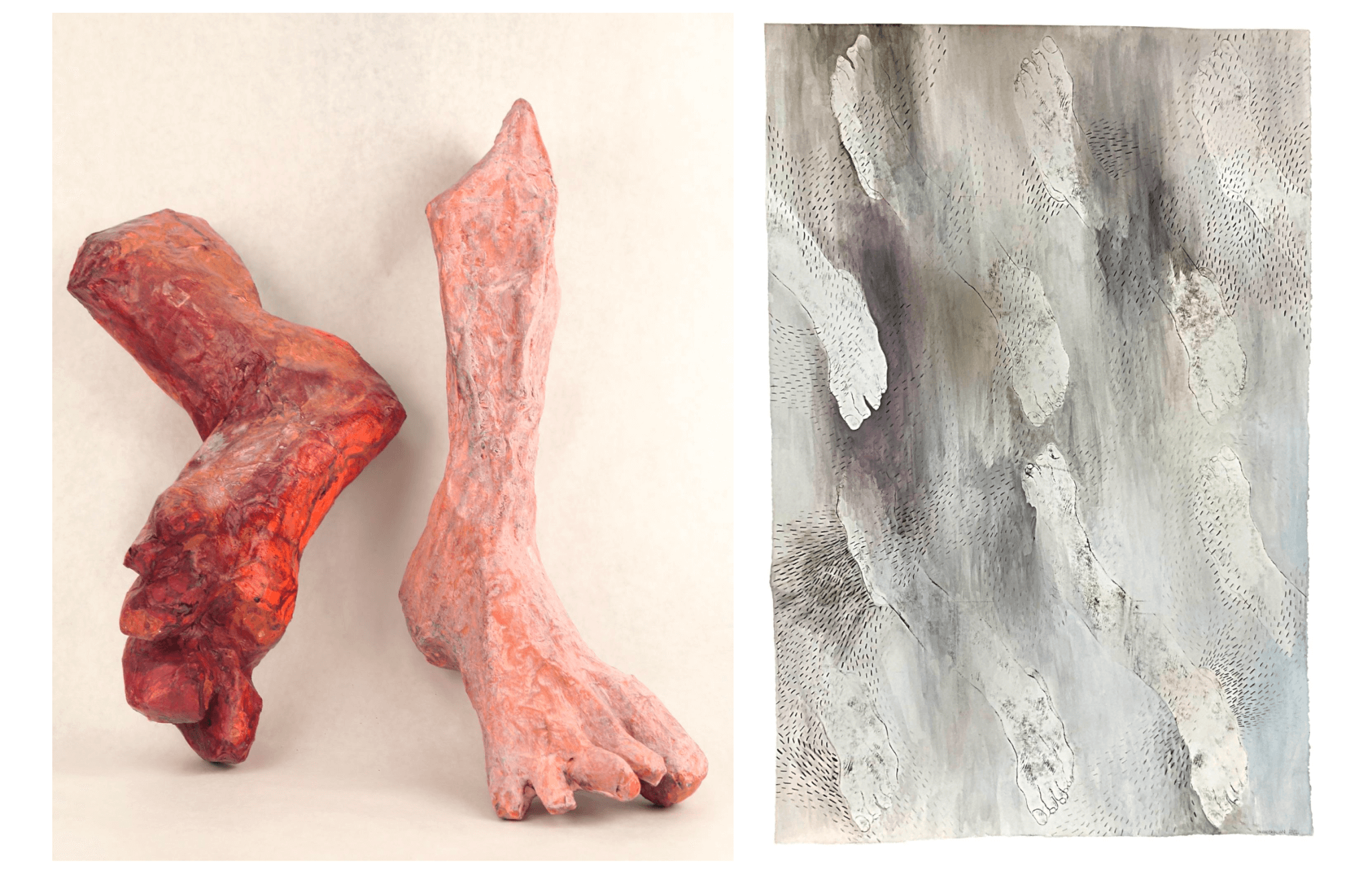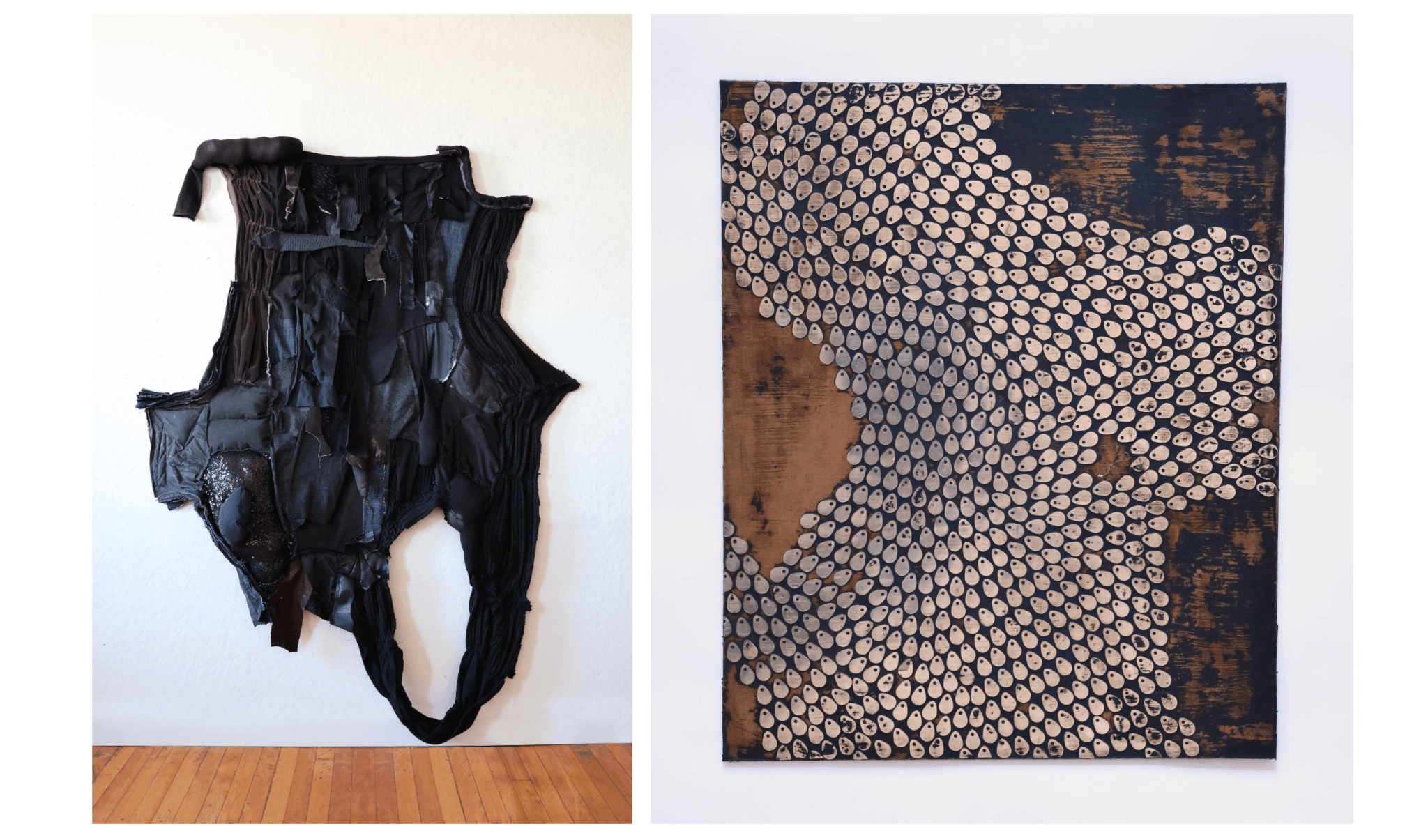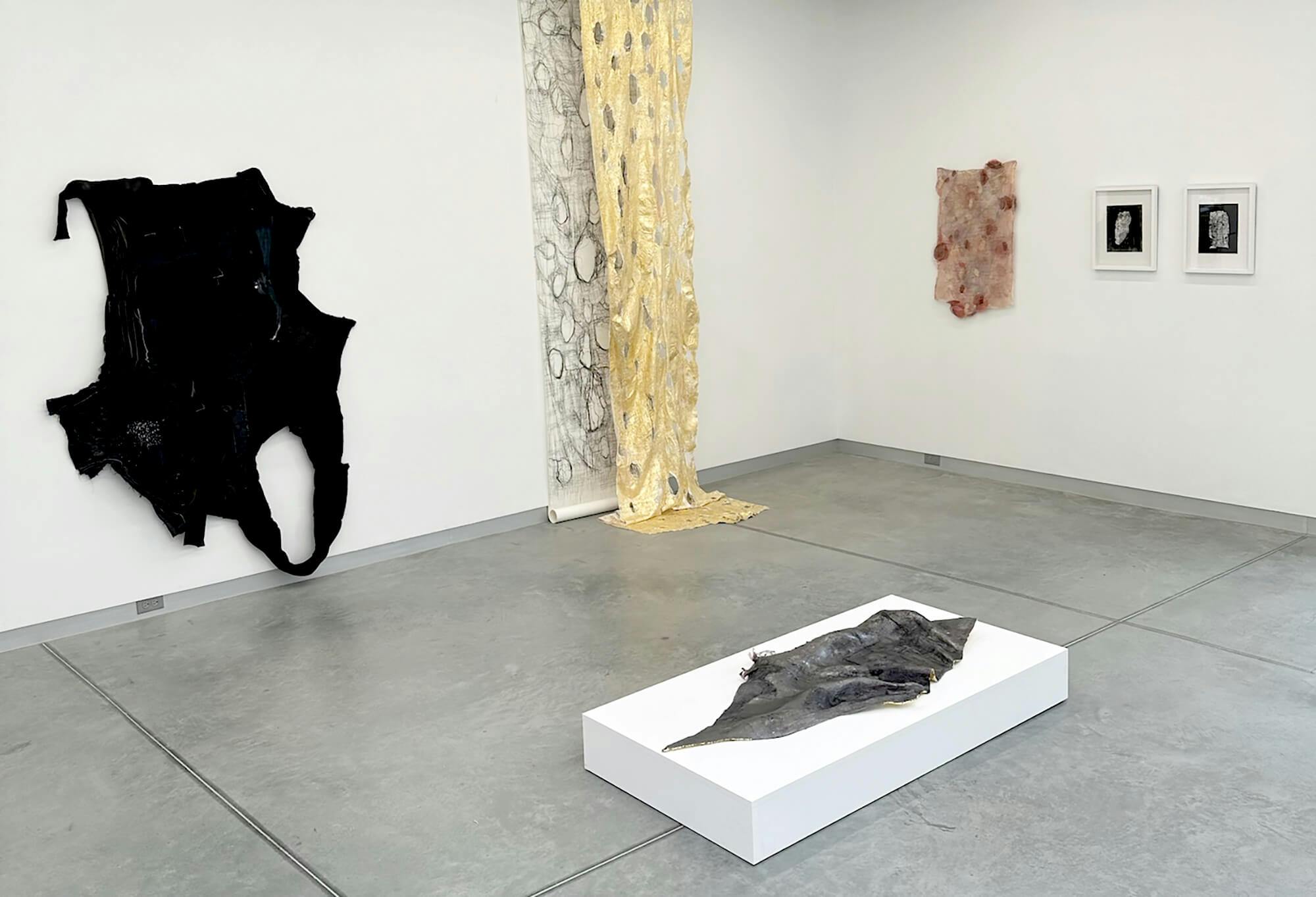Lately there’s nothing more I long for than good company: the frisson of exciting collaboration, the insights and surprises of juxtaposition—all these things are a balm as we unearth from the isolation and loneliness of the last few years. For these reasons (and then some), I was delighted by the chemistry of “Counterpoint” at the newly opened Overlap Gallery in Newport, Rhode Island.
Both the opening reception and artists’ talk for Taleen Batalian and Françoise McAree’s joint exhibition were effervescent, echoing the textured surfaces of their sculptural works, which range in media from textile to print to plaster to golden encaustics. The conversational tensions between the two bodies of work are supported both in theme and spirit by the aptly named gallery. Overlap is a welcome addition to Rhode Island’s art scene, tucked away from the most densely touristy areas of Newport. It is an artist-run exhibition space founded by ceramicist Susan Matthews, co-directed with sculptor Alicia Renadette, and dedicated to supporting contemporary art, particularly “non-traditional artwork that is rigorous in craft and concept, yet accessible in presentation and context.” Batalian and McAree’s artworks are interspersed through the two rooms of the gallery, installed as alternating syllables in an unfolding prose poem full of internal rhyme and wordplay. A vitrine contains relics of both artists’ renderings of ears and hands, while elsewhere an intaglio print of feet hangs next to a sculptural lower leg propped against the wall. The curatorial choices of “Counterpoint” keep the viewer in motion, pausing to land on the connective tissue between the artists’ works.
Batalian and McAree met in perhaps one of the most disembodied spaces, the pandemic-era Zoom classroom. They connected during a workshop with Berlin-based sculptural textile artist Sati Zech, and developed “Counterpoint” out of a desire to see the productive dissonances between their treatment of shared subjects: the body and skin. Both of their practices explore the corporeal, exhibiting the wounds and scars of process—an incision, a stitch, a pucker—but each approach the trace of experience in the body from different vantage points.
Batalian characterizes her practice as a restless search that circulates around the body, memory, and place. The traumatic legacy of her family’s survival of the Armenian genocide threads through her work; Dark Void (2023) contains multitudes and insists on obscuring meaning. Like many of her sculptural garments, it’s comprised of materials accumulated from friends and family that “articulate her own mangled unexpressed feelings.” But while the context of her artwork is heavy, the delicacy and tenderness of drawings like Father (2023) point to the shifting and slippery quality of grief and memory. I felt this acutely in her Migration series of encaustics and prints, in which the delicate paillettes swim across dark surfaces like glittering schools of fish. The density of her fabric or printed accumulations invite close looking while deflecting any clear interpretation.

(left) Françoise McAree, Subcutaneous, 2023. Cheesecloth, hand-painted fabric, thread, 22″ x 29″ x 2″. (right) Françoise McAree, Rembrandt Carcass, 2022. Hand-sewn textile, thread, wood, rope, paint, 28″ x 55″.
McAree, too, explores such paradoxical tensions. At first glance, Subcutaneous (2023) is an unassuming bit of hanging cheesecloth, but its layers embody the transparency of skin in its fragility and flexibility. The stitches and gashes read like a geologic record embedded in the body. Its poxed surface recalls a verbal motif from the artist’s statement, “a fleur de peau”—flower of the skin, idiomatically used to describe someone’s highly sensitive, raw, or emotional sensibility. Indeed, McAree’s works evoke flesh laid bare, often appearing flayed, but there’s nothing histrionic about her works: they’re precise in their messiness, and occasionally funny. I was delighted by the quotations in her work: the Baroque tenebrism of Lanfranco’s Annunciation (1624) made physical in the gold lamé-esque Descent (2022). The crucifixion of Rembrandt’s Slaughtered Ox (1655) rendered darkly cuddly in the collaged textiles of Rembrandt Carcass (2022). A few reanimated arms and feet from Géricault’s corpse studies, sculptures in paper and acrylic, are pinned to the walls of the gallery. The religious overtones of McAree’s excavation of art history are also threaded through Batalian’s works. Her “relic” images frame reverent drawings of an ear, a nose, illuminated by the protective schools of her paillettes.
History is a leitmotif of both Batalian’s and McAree’s works, and the juxtaposition of the works offers up a matrix containing art historical legacies, familial and personal history, and socio-political and embodied traumas. While we often think of history as linear, chronological, rational, the fluctuating surfaces of “Counterpoint” demonstrate its tendency to leak through porous boundaries and emerge and reemerge in unexpected ways.
I appreciate that the exhibition doesn’t start with an origin “point.” “Counterpoint,” instead, is a perpetual response, both turning back in time and towards the next step. For this viewer, this dynamism is what’s animating about the work and the collaboration. The connections between the works range from facile (how many disembodied ears can you spot?) to dissonant, continually pointing us in different directions. This insistence on the complex harmonics of “surface” and its endless iterations show us sometimes the whole rich story is skin deep.
“Counterpoint” is on view at Overlap Gallery and Project Space in Newport, Rhode Island through April 13, 2024.





